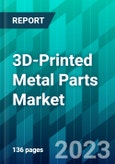The 3D-printed metal parts market experienced a slow growth of 1.4% (YoY) in 2020 due to the pandemic. In 2021, the market recuperated at an impressive rate fueled by the combined effects of the gradual recovery in air passenger traffic, higher penetration of 3D-printed parts in the medical industry during and after COVID, and an increase in automotive production. The market is likely to maintain its growth momentum and is expected to grow at an impressive CAGR of 30.2% over the next five years to reach an annual market size of US$ 43.9 billion in 2028. Key benefits of 3D printing are lighter parts, enhanced part performance, optimizes fuel consumption, reduces emissions, economical to produce complex geometries, and less material wastage. Along with these advantages, growing acceptance of 3D printing technology in different end-use industries, expected increase in the production rate of key programs (A320neo, B737 Max, A220, B787, and A350XWB), increase in automotive production, and the growing medical devices market are likely to give an impetus to the demand for 3D-printed metal parts in the coming years.
Recent Market JVs and Acquisitions:
- In 2021, Desktop Metal acquired ExOne, a leading additive manufacturing company with a transaction value of US$ 561.3 million
- Also, in 2021, Proto Labs, Inc. acquired 3D Hubs, Inc. for an aggregate closing consideration of US$ 280 million. The acquisition helped Proto Labs, Inc. to provide industry-leading digital manufacturing solutions from idea to prototype to full end-use part production
- Stryker acquired Wright Medical Group N.V., a global medical device company in 2021, with an enterprise value of US$ 5.4 billion (approx.). Wright Medical Group N.V. is one of the leading players in 3D-printed ankle replacements
- In 2018, ATI acquired Addaero Manufacturing, latter is one of the leaders in metal alloy-based additive manufacturing for the aerospace & defense industry. Based on the metal type, the market is segmented into steel, nickel alloys, titanium alloys, aluminum alloys, cobalt alloys, and others. Titanium alloy is estimated to remain the most dominant metal type in the market till 2028. Due to their lightweight, low thermal conductivity, high mechanical strength, and lower buy-to-fly ratio, they are preferred for the aerospace industry. Key applications for aerospace are airframe, wing structures, compressor blades, rotors, brackets, and other turbine engine components. Aluminum alloys, under the spotlight, are expected to record the highest growth during 2023-2028
Among the end-use industry types, the market is segmented into aerospace & defense, medical, automotive, energy, and others. Aerospace & defense is expected to remain the largest and fastest-growing end-use industry type in the market during the forecast period owing to the increasing demand from aerospace engine component manufacturers due to 3D printing’s high precision, accuracy, and ability to print complex geometries. In the aerospace industry, metal 3D printing is used in a wide range of applications, from functional prototypes to tooling, replacement parts, and structural aircraft components.
In terms of regions, North America is expected to remain the largest market for 3D-printed metal parts during the forecast period. The USA had the world's largest 3D-printed metal parts market, followed by China and Germany in 2022. Asia-Pacific is estimated to mark the highest growth during the forecast period. China is the dominant 3D printing market in the region, driven by the “Additive Manufacturing Industry Development Action Plan” by the Chinese government. The market is fairly consolidated with the presence of some regional and global players. An inorganic growth strategy is preferred, especially by the leading players. Several crucial M&As led to several changes in the competitive landscape. The following are the key players in the 3D-printed metal parts market.
- GKN Powder Metallurgy (A Melrose Plc Company)
- GE Additive (Part of GE Electric)
- Stryker
- MTU Aero Engines AG
- Sandvik AB
- Oerlikon This strategic assessment report provides a comprehensive analysis that reflects today’s 3D-printed metal parts market realities and future market possibilities for the forecast period
This report offers high-quality insights and is the outcome of a detailed research methodology comprising extensive secondary research, rigorous primary interviews with industry stakeholders, and validation and triangulation with the publisher's internal database and statistical tools.
More than 1,000 authenticated secondary sources, such as company annual reports, fact books, press releases, journals, investor presentations, white papers, patents, and articles, have been leveraged to gather the data.
The publisher conducted more than 8 detailed primary interviews with the market players across the value chain in all four regions and industry experts to obtain both qualitative and quantitative insights.








